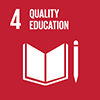Description/achievement of initiative
The Global Action Programme on ESD pursues the overall objective to use ESD as a key driver for contributing to the resilience and sustainability of Societies. The Partner Networks of the Global Action Programme will bring together ESD stakeholders from different world regions to exchange experiences and learn from successful cases in implementing ESD in national education systems. SIDS have been a priority target group of UNESCO's Climate Change Education country programmes in 2012-2015. Recommendations and lessons learned from these activities provide an important knowledge pool to draw upon. Based on their rich experiences and knowledge, SIDS stakeholders are expected to play an important role in further accelerating ESD action.Apart from interlinking and scaling up existing networks, the GAP aims at triggering further commitments to new ESD action in line with one or more of the five Priority Action Areas of the GAP.
Implementation methodologies
In order to harness networks and partnerships among stakeholders, UNESCO will put in place a partnership mechanism for the GAP. Five Partner Networks one for each of the Priority Action Areas – will be set up. Stakeholders who have an extensive outreach capacity and can make a political impact will be invited to join these Partner Networks. The Networks will contribute to creating synergies of activities within and across the Priority Actions Areas, consolidating and accelerating actions across geographic, knowledge and sectoral boundaries and catalysing actions by other stakeholders. With SIDS being a critical target group of UNESCO's ongoing ESD and climate change education work, a particular focus will be on harnessing collaboration between SIDS and engaging with SIDS as part of the Networks.
Arrangements for Capacity-Building and Technology Transfer
GAP commitments will be implemented by partners in the relevant countries. Stakeholders who are invited to join the Partner Networks will interface directly with UNESCO as key partners who spearhead the implementation of concrete activities in the Priority Action Areas. The GAP will harness the technical expertise, outreach capacity and financial resources of key partners, accelerating the international community's pursuit of sustainable development. Key partners may engage in joint work, while they continue to individually undertake activities to achieve their launch commitments. The Global Forum and a GAP clearinghouse, coordinated by UNESCO, will additionally foster exchange of experiences, capacity building and knowledge transfer.
Coordination mechanisms/governance structure
UNESCO will create a Global Action Programme (GAP) Secretariat to assist among others in the overall coordination of the GAP, its Partner networks and the Global Forum on ESD. The GAP Secretariat will liaise closely with national focal points for the GAP and will seek the advice of a multi-stakeholder advisory group.
Partner(s)
Partner Networks of the Global Action Programme (GAP) on Education for Sustainable Development (ESD).
In the course of the UN Decade of Education for Sustainable Development (2005-2014) UNESCO has supported the integration of ESD, in particular of Climate Change Education in partnership with a number of SIDS. This activity will now be scaled up under the Global Action Programme on ESD, the official follow up to the UN Decade of ESD, which will be launched in November 2014. The GAP will focus on five Priority Action Areas: Policy integration, Whole-organization approaches, Educators, Youth and Local communities. GAP Partner Networks will consist of diverse stakeholders having made major commitments to support one or more of the five Priority Action Areas. The Networks will provide a major platform for bringing together a diversity of SIDS stakeholders.


 2015
2015
 November 2014-2019
November 2014-2019
 November 2014-2019
November 2014-2019
 Time-frame: 0000-00-00 - November 2019
Time-frame: 0000-00-00 - November 2019